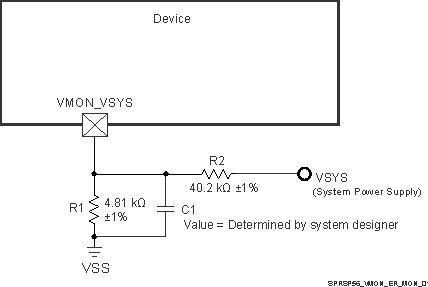ZHCSRW0C February 2023 – November 2025 AM68 , AM68A
PRODUCTION DATA
- 1
- 1 特性
- 2 应用
- 3 说明
- 4 器件比较
-
5 端子配置和功能
- 5.1 引脚图
- 5.2 引脚属性
- 5.3
信号说明
- 13
- 5.3.1 ADC
- 5.3.2 DDRSS
- 5.3.3 GPIO
- 5.3.4 I2C
- 5.3.5 I3C
- 5.3.6 MCAN
- 5.3.7 MCSPI
- 5.3.8 UART
- 5.3.9 MDIO
- 5.3.10 CPSW2G
- 5.3.11 ECAP
- 5.3.12 EQEP
- 5.3.13 EPWM
- 5.3.14 USB
- 5.3.15 显示端口
- 5.3.16 HyperLink
- 5.3.17 PCIE
- 5.3.18 SERDES
- 5.3.19 DSI
- 5.3.20 CSI
- 5.3.21 MCASP
- 5.3.22 DMTIMER
- 5.3.23 CPTS
- 5.3.24 DSS
- 5.3.25 GPMC
- 5.3.26 MMC
- 5.3.27 OSPI
- 5.3.28 Hyperbus
- 5.3.29 仿真和调试
- 5.3.30 系统和其他
- 5.3.31 电源
- 5.4 未使用引脚的连接
-
6 规格
- 6.1 绝对最大额定值
- 6.2 ESD 等级
- 6.3 建议运行条件
- 6.4 通电时间 (POH) 限制
- 6.5 运行性能点
- 6.6 电气特性
- 6.7 一次性可编程 (OTP) 电子保险丝的 VPP 规格
- 6.8 热阻特性
- 6.9 温度传感器特性
- 6.10
时序和开关特性
- 6.10.1 时序参数和信息
- 6.10.2 电源时序控制
- 6.10.3 系统时序
- 6.10.4 时钟规格
- 6.10.5
外设
- 6.10.5.1 ATL
- 6.10.5.2 CPSW2G
- 6.10.5.3 CSI-2
- 6.10.5.4 DDRSS
- 6.10.5.5 DSS
- 6.10.5.6 eCAP
- 6.10.5.7 EPWM
- 6.10.5.8 eQEP
- 6.10.5.9 GPIO
- 6.10.5.10 GPMC
- 6.10.5.11 HyperBus
- 6.10.5.12 I2C
- 6.10.5.13 I3C
- 6.10.5.14 MCAN
- 6.10.5.15 MCASP
- 6.10.5.16 MCSPI
- 6.10.5.17 MMCSD
- 6.10.5.18 CPTS
- 6.10.5.19 OSPI
- 6.10.5.20 PCIE
- 6.10.5.21 计时器
- 6.10.5.22 UART
- 6.10.5.23 USB
- 6.10.6 仿真和调试
- 7 详细说明
- 8 应用、实施和布局
- 9 器件和文档支持
- 10修订历史记录
- 11机械、封装和可订购信息
8.2.4 使用 VMON/POK 的系统电源监测设计指南
VMON1_ER_VSYS 引脚提供了一种监测系统电源的方法。该系统电源通常是用于整个系统的单个预稳压电源。监测该电源的方法是将该电源供电的外部分压器电路的输出电压与内部电压基准进行比较,当施加到 VMON1_ER_VSYS 的电压降至内部基准电压以下时,将触发电源故障事件。在选择用于实现外部电阻分压器电路的元件值时,系统设计人员可确定实际系统电源电压跳闸点。在设计电阻分压器电路时,必须了解导致系统电源监测跳闸点可变性的各种因素,这一点很重要。首先要考虑的是 VMON1_ER_VSYS 输入阈值的初始精度,其标称值为 0.45V,变化为 ±3%。建议使用具有相似热系数的精度为 1% 的电阻器来实现电阻分压器。这可更大程度地减小电阻值容差导致的可变性。还必须考虑与 VMON1_ER_VSYS 相关的输入漏电流,因为任何流入引脚的电流都会在分压器输出上产生负载误差。当施加 0.45V 电压时,VMON1_ER_VSYS 输入漏电流范围可能为 10nA 至 2.5µA。
电阻分压器的设计应确保在正常运行条件下,其输出电压绝不超过建议运行条件 中定义的最大值。
图 8-5 给出了一个示例,其中系统电源的标称电压为 5V,最大触发阈值为 5V - 10% 或 4.5V。
对于此示例,必须在选择电阻值时了解哪些变量会影响最大触发阈值,这一点很重要。显然,在尝试设计一个在系统电源下降 10% 之前不会跳闸的分压器时,需要考虑 VMON1_ER_VSYS 输入阈值为 0.45V + 3% 的器件。还需要考虑电阻器容差和输入漏电流的影响,但这些因素对最大触发点的影响可能并不明显。在选择会产生最大触发电压的元件值时,系统设计人员必须考虑以下情况:R1 的值为 1% 低、R2 的值为 1% 高,再加上 VMON1_ER_VSYS 引脚的输入漏电流为 2.5µA。当实现 R1 = 4.81KΩ 且 R2 = 40.2KΩ 的电阻分压器时,结果是最大触发阈值为 4.523V。
一旦选择了满足上述最大触发电压的元件值,系统设计人员就可以通过计算施加的电压来确定最小触发电压,该电压可在 R1 的值为 1% 高、R2 的值为 1% 低且输入漏电流为 10nA 或零时产生 0.45V - 3% 的输出电压。使用零输入漏电流和上面给出的电阻器值,结果为最小触发阈值 4.008V。
该示例演示了一个范围为 4.008V 至 4.523V 的系统电源电压跳闸点。当 VMON1_ER_VSYS 输入漏电流为 2.5µA 时,该范围中约 250mV 是通过 ±3% 的 VMON1_ER_VSYS 输入阈值精度引入的,约 150mV 是通过 ±1% 的电阻容差引入的,约 100mV 是通过负载误差引入的。
当系统电源为 4.5V 时,该示例中选择的电阻值会通过电阻分压器产生大约 100µA 的偏置电流。通过将流经电阻分压器的偏置电流增大至大约 1mA,可将上述 100mV 的负载误差降低至大约 10mV。因此,系统设计人员在选择元件值时需要考虑电阻分压器偏置电流与负载误差之间的关系。
由于 VMON1_ER_VSYS 具有极小的迟滞和对瞬态的高带宽响应,系统设计人员还应考虑在分压器输出端实现噪声滤波器。这可通过在 R1 上安装一个电容器来实现,如图 8-5 所示。然而,系统设计人员必须根据系统电源噪声和对瞬态事件的预期响应来确定此滤波器的响应时间。
图 8-5 给出了一个示例,其中系统电源的标称电压为 5V,所需的触发阈值为 -10% 或 4.5V。
 图 8-5 系统电源监测分压器电路
图 8-5 系统电源监测分压器电路VMON2_IR_VCPU 引脚提供了一种监测 VDD_CPU 电源的方法。TI 建议在外部将 VMON2_IR_VCPU 引脚连接到尽可能靠近电路板上 VDD_CPU 引脚的位置。具有 VMON6_IR_VEXT0P8 的 SoC 可以选择监测其他域,例如 VDD_CORE 或 VDD_MCU。同样,这些信号应尽可能靠近电路板上的 VDD_CORE 或 VDD_MCU 引脚。
VMON3_IR_VEXT1P8 和 VMON4_IR_VEXT1P8 引脚提供了一种监测外部 1.8V 电源的方法。VMON5_IR_VEXT3P3 引脚提供了一种监测外部 3.3V 电源的方法。SoC 内部实施了一个具有软件控制功能的内部电阻分压器。软件可以对这个内部电阻分压器进行编程,以创建适当的欠压和过压中断。这些引脚不应由外部电阻分压器供电。如果监测的电压需要调整,请务必在连接到监测引脚之前缓冲分压电压。